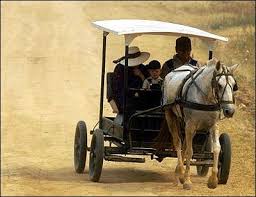 All six children and their parents in denim overalls. All flaxen-haired, pale-skinned. Ultramarine blue eyes set into their identical round faces. Each child an inch shorter than the sibling standing next to them. Mom, Dad, and their flock lined up in a row beside me in the air-conditioned ice cream parlor. No one wants to languish outside in the stifling heat to eat their ice cream. Mesmerized, I stare. All eight of them are licking their vanilla cones in synchronistic upward laps. Very, very slowly.
All six children and their parents in denim overalls. All flaxen-haired, pale-skinned. Ultramarine blue eyes set into their identical round faces. Each child an inch shorter than the sibling standing next to them. Mom, Dad, and their flock lined up in a row beside me in the air-conditioned ice cream parlor. No one wants to languish outside in the stifling heat to eat their ice cream. Mesmerized, I stare. All eight of them are licking their vanilla cones in synchronistic upward laps. Very, very slowly.
This family first caught my attention when they pulled up in a horse-drawn buggy. Where was I? South America or the American heartland?
I knew where I am alright, and I don’t want to be here. A freaky place in the Oriente jungle of Bolivia. Hot, steamy, oppressive. This hamlet is very peculiar and it has just gotten weirder when the blond clones pull up in their antiquated form of transport. They are in complete juxtaposition from the businessmen in dark suits and briefcases strutting across the dirt plaza. The plaza, like the town, is depressing—ornamented with a few limp palm trees and splintered benches around the perimeter.
What are these suits doing in this god forsaken outpost?
Pointing out the window, I ask the man scooping the ice cream. “Who are those men sporting expensive sunglasses and Italian leather shoes? Why are they here?”
I can’t ask him about the strange blond family, as they are listening. They have leaned toward me, heads cocked to the side in unison—like birds sitting on a wire.
I have more questions for him, ”How did those businessmen even get here?” It had taken me 12 hours in an overnight, over-crowded bus. Their Armani suits aren’t even wrinkly and is that a pink silk tie?
The shop owner leans across the counter, shushes me with a wave of his hand, and whispers, “They are here to buy cocaine. They fly in on private jets from Miami.”
“What!?!” I yell, startling the ice cream lickers.
So here I am in the air-conditioned ice cream parlor scratching my head at the cocaine idea plus farmers in horse-drawn carriages. What exactly is going on here in Santa Cruz, Bolivia? I’m passing through to access the river that flows into Brazil and ride the coal-fueled iron horse that runs from the nearby border into Paraguay. I was expecting macaw-feathered, tattooed tribal dudes with blowguns—not American businessmen with embossed briefcases and coke straws or American Gothic farmers.
The fans turn slowly, churning the cold air between our bodies as we lick our ice cream cones. There is only one flavor—vanilla. I lap in silent unison with my pale, overall-clad breathern and ponder, “What other freaks live in this weird place?”
It dawned on me that Santa Cruz, Bolivia was not only the home to very inbred colonists, but also the epicenter for cocaine manufacturing. I hightailed it out of there to the oddly more normal bug-invested jungle and its tangle of rivers.
![]() This vivid memory from 1975, was reignited when I read the essay titled “Step Back in Time With the Mennonites of Bolivia” by photographer Jordi Busqué in National Geographic. His astonishing essay and photographs are the result of a ten year research project interviewing Mennonite colonists near Santa Cruz.
This vivid memory from 1975, was reignited when I read the essay titled “Step Back in Time With the Mennonites of Bolivia” by photographer Jordi Busqué in National Geographic. His astonishing essay and photographs are the result of a ten year research project interviewing Mennonite colonists near Santa Cruz.
![]()
Here is story I also wrote about my travels in Bolivia encountering another peculiar family: Sole Food
Loved it, fun to read. I was transported to Bolivia for a few precious moments. Thanks, took my mind off other things.
I hope we can resume our writing meetings in the future. I may be coming over to board up Ocean House when I return from Spain. I’ll keep I touch. Luv! Lisa